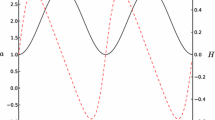Abstract
The Stephani universes that can be interpreted as an ideal gas evolving in local thermal equilibrium are determined. Five classes of thermodynamic schemes are admissible, which give rise to five classes of regular models and three classes of singular models. No Stephani universes exist representing an exact solution to a classical ideal gas (one for which the internal energy is proportional to the temperature). But some Stephani universes may approximate a classical ideal gas at first order in the temperature: all of them are obtained. Finally, some features about the physical behavior of the models are pointed out.
Similar content being viewed by others
References
means here, in a technical sense, at least for all the energy tensors containing more than four variables, as it will become clear in the next paragraph
All the causal closures that have been proposed in the literature for arbitrary fluids are (or may be related to) thermodynamical closures, originated in relativity from many different approaches and giving rise to very different results. They essentially started with Eckart’s third paper on thermodynamics of irreversible processes, and their contrast with Landau and Lifchitz’s point of view produced a great number of new propositions, more or less decanted over the works by Israel, Steward and Marle, and subsequently over the relativistic version of extended thermodynamics
Apart from the barotropic one. The barotropic closure for a perfect fluid energy tensor states that the energy density ρ is a function of the sole pressure p,ρ = f(p). It remains that, very frequently, this relation is considered as an equation of state consequence of the rheology of the fluid (what is of relatively little interest), better than as a particular evolution restriction (which offers a rich range of interest). See [13] for this concept
By this and the other reasons mentioned above, in the rest of the paper to the appellations ‘perfect fluid space-times’ or ‘perfect fluid solutions’ (to Einstein equations), we prefer those of ‘perfect energy tensor space-times’ or ‘perfect energy tensor solutions’
Coll, B., Ferrando, J.J.: J. Math. Phys. 30, 2918 (1989) See also [13] and [7]
An important consequence of the purely hydrodynamic physical meaning of the local thermal equilibrium is that it suggests a precise hierarchy of irreversiblility levels, the lowest one being the usual evolution in local thermal equilibrium and the successive other levels corresponding to increasing irreversibility. But this aspect will be analysed elsewhere
Coll, B., Ferrando, J.J.: Physics of relativistic perfect fluids, Some topics on general relativity and gravitational radiation. Ed. Frontières, Paris, p. 187 (1997) Preprint gr-qc/0312025.
Stephani, H.: Commun Math. Phys. 4, 137 (1967)
Bona, C., Coll, B.: Gen. Rel. Grav. 20, 279 (1988)
Krasiński, A., Quevedo, H., Sussman, R.A.: J. Math. Phys. 28, 2602 (1997)
Sussman, R.A.: Gen. Rel. Grav. 32, 1572 (2000)
We refer to a generic ideal gas if it satisfies the equation of state p = krT. Then, in general, ε=ε(T). We refer to a classical ideal gas when this energetic equations of state is ε = c v T, c v being a constant
Coll, B., Ferrando, J.J.: On the relativistic compressibility conditions (2005) (to be submitted)
Coll, B., Ferrando, J.J.: Ideal gas Stephani universes, Reference frames and gravitomagnetism. World Scientific, Singapore, p. 279. Preprint (2001) gr-qc/0312026
Barnes, A.: Gen. Rel. Grav. 4, 105 (1973)
Lichnerowicz, A.: Magnetohydrodynamics: waves and shock waves in curved space-time. Kluwer Academic Publishers, Dordrecht (1994)
Author information
Authors and Affiliations
Corresponding author
Rights and permissions
About this article
Cite this article
Coll, B., Ferrando, J.J. Local thermal equilibrium and ideal gas Stephani universes. Gen Relativ Gravit 37, 557–573 (2005). https://doi.org/10.1007/s10714-005-0042-y
Received:
Published:
Issue Date:
DOI: https://doi.org/10.1007/s10714-005-0042-y



